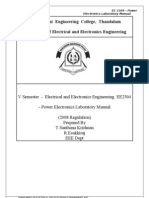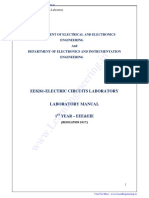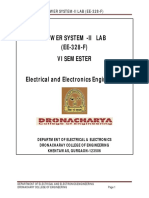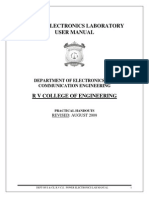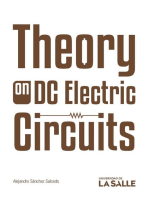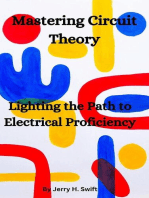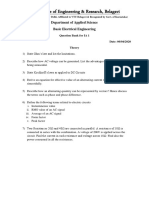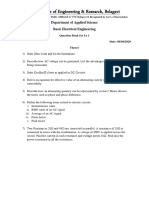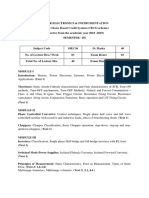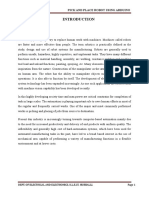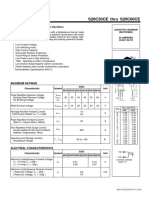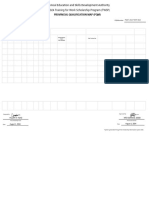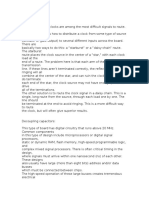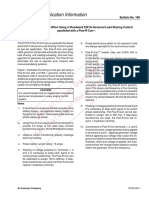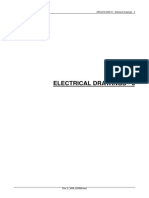Lab Manual
Lab Manual
Uploaded by
chaitanyaCopyright:
Available Formats
Lab Manual
Lab Manual
Uploaded by
chaitanyaOriginal Description:
Copyright
Available Formats
Share this document
Did you find this document useful?
Is this content inappropriate?
Copyright:
Available Formats
Lab Manual
Lab Manual
Uploaded by
chaitanyaCopyright:
Available Formats
Basic Electrical Engineering Laboratory,18EEL17/27
Basic Electrical Engineering Laboratory, 18ELEL17/18ELEL27
[As per Choice Based Credit System (CBCS) scheme]
SEMESTER – I/II
NAME OF STUDENT
ROLL NO:
SECTION
BATCH NO :
Staff in charge
DEPARTMENT OF ELECTRICAL AND ELECTRONICS
S.T.J.INSITITUTE OF TECHNOLOGY RANEBENNUR -581115
Prepared by Prof. SANTHOSH RAIKAR M
More suggestion and feedback mail @: acadamiceeestjit@gmail.com
Department of Electrical & Electronics ,S.T.J.I.T.Rnr ,SRM AP Page 1
Basic Electrical Engineering Laboratory,18EEL17/27
Safety Precautions
1. SAFETY is of paramount importance in the Electrical Engineering Laboratories.
2. Electricity NEVER EXCUSES careless persons. So, exercise enough care and attention in
handling electrical equipment and follow safety practices in the laboratory. (Electricity is a good
servant but a bad master).
3. Avoid direct contact with any voltage source and power line voltage. (Otherwise and such
contact may subject you to electrical shock).
4. Wear rubber-soled shoes. (To insulate you from earth so that even if you accidentally contact a
live point, current will not flow through your body to earth and hence you will be protected from
electrical shock)
5. Wear laboratory-coat and avoid loose clothing. (Loose clothing may get caught on an
equipment/instrument and this may lead to an accident particularly if the equipment happens to
be a rotating machine)
6. Girl students should have their hair tucked under their coat or have it in a knot.
7. Do not wear any metallic rings, bangles, bracelets, wristwatches and neck chains. (When you
move your hand/body, such conducting items may create a short circuit or may touch a live point
and thereby subject you to electrical shock).
8. Be certain that your hands are dry and that you are not standing on wet floor. (Wet parts of the
body reduce the contact resistance thereby increasing the severity of the shock).
9. Ensure that the power is OFF before you start connecting up the circuit. (Otherwise you will
be touching the live parts in the circuit)
10. Get you circuit diagram approved by the staff member and connect up the circuit strictly as
per the approved circuit diagram.
11. Check power chords for any sign of damage and be certain the chords use safety plugs and
do not defeat the safety future of these plugs by using ungrounded plugs.
12. When using connection leads, check for any insulation damage in the leads and avoid such
defective leads.
13. Do not defeat any Safety devices such as fuse or circuit breaker by shorting across it. Safety
devices protect YOU and your equipment
14. Switch on the power to your circuit and equipment only after getting them checked up and
approved by the staff member.
Department of Electrical & Electronics ,S.T.J.I.T.Rnr ,SRM AP Page 2
Basic Electrical Engineering Laboratory,18EEL17/27
15. Take the measurement with one hand in you pocket. (To avoid shock in case you accidentally
touch two points at different potentials with your two hands)
16. Do not make any change in the connection without the approval of the staff member.
17. In case you notice any abnormal condition in your circuit (like insulation heating up, resistor
heating up etc.). Switch off the power to your circuit immediately and inform the staff member.
18. Keep hot soldering iron in the holder when not in use.
19. After completing the experiment show your readings to the staff member and switch off the
power to your circuit after getting approval from the staff member.
Electrical Symbols
Single-pole Single-throw
(SPST) Switch Single Pole Double-throw (SPDT) Switch
Double-pole, Single Throw (DPST) Switch
Fuse
Department of Electrical & Electronics ,S.T.J.I.T.Rnr ,SRM AP Page 3
Basic Electrical Engineering Laboratory,18EEL17/27
List of experiments:
1. Verification of KVL and KCL for DC circuits. -04
2. Measurement of current, power and power factor of incandescent lamp, fluorescent lamp, and
CFL and LED lamp. -06
3. Impedance calculation and verification for R-L and R-C circuits- using decade boxes.-09
4. Load test on a single phase transformer.-12
5. Voltage and Current relationships of three phase star/delta circuits.-14
6. Measurement of three phase power using two wattmeter method.-16
7. Speed load characteristic of a 3 phase induction motor.-18
8. Two way and three way Control of lamp and formation of truth table.-20
Demonstration Experiments (for CIE only):
1. Demonstration of fuse, MCB by creating a fault.-21-22
2. Demonstration of cut-out sections of electrical machines (DC machines, Induction machines
and synchronous machines)
Laboratory Outcomes
Get an exposure to common electrical components.
Make electrical connections by wires of appropriate ratings.
Understand the usage of common electrical measuring instruments.
Understand the basic functioning of electrical machines.
Department of Electrical & Electronics ,S.T.J.I.T.Rnr ,SRM AP Page 4
Basic Electrical Engineering Laboratory,18EEL17/27
Experiment no 1 : Verification of KVL and KCL for DC circuits.
Aim: Determination of Voltage and Current in DC Circuit
Apparatus required
Slno Apparatus Specification Quantity
1 RPS unit 0-24/30V 1
2 PMMC ammeter 0-2/5A 3
3 Rheostat 100 ohm 2A 3
4 Connecting wires - -
Theory :
Statement:
KCL: The algebraic sum of the currents meeting at a node is equal to zero.
KVL: In any closed path / mesh, the algebraic sum of all the voltages is
zero. Precautions:
1. Voltage control knob should be kept at minimum position.
2. Current control knob of RPS should be kept at maximum position.
Procedure for KCL:
1. Give the connections as per the circuit diagram.
2. Set a particular value in RPS.
3. Note down the corresponding ammeter reading
4. Repeat the same for different voltages
Procedure for KVL:
1. Give the connections as per the circuit diagram.
2. Set a particular value in RPS.
3. Note all the voltage reading
4. Repeat the same for different voltages Kcl
Department of Electrical & Electronics ,S.T.J.I.T.Rnr ,SRM AP Page 5
Basic Electrical Engineering Laboratory,18EEL17/27
Calculation
Slno Reading of Reading of Reading of I2+I3
ammeter 1 (I1) ammeter 2 (I2) ammeter 3(I3)
1
2
3
4
Slno Reading of Reading of Reading of V2+V3
voltmeter 1(V1) voltmeter 2 voltmeter 3(V3)
(V2)
1
2
3
4
Apply the loop and nodal analysis calculate theoretical value of current and voltage from
network
Department of Electrical & Electronics ,S.T.J.I.T.Rnr ,SRM AP Page 6
Basic Electrical Engineering Laboratory,18EEL17/27
Experiment 2 Measurement of current, power and power factor of
incandescent, lamp, fluorescent lamp, CFL and LED lamp.
Aim: Measurement of current, power and power factor of incandescent lamp, fluorescent lamp,
CFL and LED lamp.
Apparatus Required:
Slno Apparatus Specification Quantity
1 Fluorescent tube 40W 1
2 Starter 5A 1
3 Choke coil 10A,230V 1
4 Wattmeter 2500,250V,10A 1
5 Voltmeter ammeter 250v,10/20A 2
Figure 1 fluorescent lab
Department of Electrical & Electronics ,S.T.J.I.T.Rnr ,SRM AP Page 7
Basic Electrical Engineering Laboratory,18EEL17/27
Theory:
1. The electrode of the starter which is enclosed in a gas bulb filled with argon gas, cause
discharge in the argon gas with consequent heating.
2. Due to heating, the bimetallic strip bends and causes in the starter to close. After this, the
choke, the filaments (tube ends) to tube and starter becomes connected in series.
3. When the current flows through the tube end filaments the heat is produced. During the
process the discharge in the starter tube disappears and the contacts in the starter move apart.
4. When sudden break in the circuit occur due to moving apart of starter terminals, this causes a
high value of e.m.f to be induced in the choke.
5. According to Lenz‟s, the direction of induced e.m.f in the choke will try to oppose the fall of
current in the circuit.
6. The voltage thus acting across the tube ends will be high enough to cause a discharge to occur
in the gas inside the tube. Thus the starts giving light.
7. The fluorescent lamp is a low pressure mercury lamp and is a long evacuated tube. It contains
a small amount of mercury and argon gas at 2.5 mm pressure. At the time of switching in the
tube mercury is in the form of small drops. Therefore, to start the tube, filling up of argon gas is
necessary. So, in the beginning, argon gas starts burning at the ends of the tube; the mercury is
heated and controls the current and the tube starts giving light. At each end of the tube, there is a
tungsten electrode which is coated with fast electron emitting material. Inside of the tube is
coated with phosphor according to the type of light.
8. A starter helps to start the start the tube and break the circuit. The choke coil is also called
blast. It has a laminated core over which enameled wire is wound. The function of the choke is to
increase the voltage to almost 1000V at the time of switching on the tube and when the tube
starts working, it reduces the voltage across the tube and keeps the currents constant.
Procedure:
1. Give the connections as per the circuit diagram
2. Fix the tube holder and the choke in the tube.
3. The phase wire is connected to the choke and neutral directly to the tube.
4. Connect the starter in series with the tube.
5. Switch on the supply and check the fluorescent lamp lighting.
Department of Electrical & Electronics ,S.T.J.I.T.Rnr ,SRM AP Page 8
Basic Electrical Engineering Laboratory,18EEL17/27
Tabular column
Slno Current Voltage Power Power factor
Power P=VICOS from above equation calculate power factor of different lamp
Department of Electrical & Electronics ,S.T.J.I.T.Rnr ,SRM AP Page 9
Basic Electrical Engineering Laboratory,18EEL17/27
Experiment no 3 Impedance calculation and verification for R-L and R-C
circuits- using decade boxes.
Aim Impedance calculation and verification for R-L and R-C circuits- using decade boxes.
Apparatus Required
Slno Components Range/type Quantity
1 Voltmeter 0-300V MI 1
2 Ammeter 0-10A MI 1
3 Wattmeter 300V 10A UPF/LPF 1
4 Autotransformer 1KVA 230V 1
5 Resistance inductance 1
and capacitance box
6 Connecting wire As per requirement
Theory:
Power in an electric circuit can be measured using a wattmeter. A wattmeter consists of two coils,
namely current coil and pressure coil or potential coil. The current coil is marked as ML and
pressure coil is marked as CV. The current coil measures the quantity that is proportional to The
current in the circuit and the pressure measures quantity that is proportional to voltage in the
Circuit. An ammeter is connected in series to the wattmeter to measure the current. A voltmeter is
connected in parallel to wattmeter to measure voltage. The power factor of the circuit is
calculated using the relation given below:
Circuit diagram
With resitive load
Department of Electrical & Electronics ,S.T.J.I.T.Rnr ,SRM AP Page 10
Basic Electrical Engineering Laboratory,18EEL17/27
Procedure:
1. Connect the circuit as shown in the circuit diagram
2. Switch on the supply and vary the auto transformer to build the rated voltage.
3. Vary the load according to current values are increases linearly for different ratings.
4. Note down the ammeter, wattmeter readings. Voltage will maintain constant.
5. After taking all the reading, bring the voltage back to minimum in the auto transformer.
6. Switch off the power supply. Remove the connections.
7. Calculate the power factor by the given formula
Procedure with RL/RC decade’s boxes
1. Connect the circuit as shown in the circuit diagram
2. Switch on the supply and vary the auto transformer to build the rated voltage.
3. Observe the reading of ammeter, voltmeter and wattmeter for various load values.
4. Vary the load according to current readings. Voltage is maintained constant.
5. After taking all the reading, bring the voltage back to minimum in the auto transformer.
6. Switch off the power supply.
7. Calculate the power factor by the given formula.
Actual power = OR x multiplication factor
Apparent power = VI watts
Power factor, Cos = (Actual power) / (Apparent power)
Department of Electrical & Electronics ,S.T.J.I.T.Rnr ,SRM AP Page 11
Basic Electrical Engineering Laboratory,18EEL17/27
Tabular column
Slno Current Voltage Power Power factor Impedance
Z= Z=V/I cosR/Z
Department of Electrical & Electronics ,S.T.J.I.T.Rnr ,SRM AP Page 12
Basic Electrical Engineering Laboratory,18EEL17/27
Experiment 4 Load test on a single phase transformer.
Aim Load test on a single phase transformer.
Apparatus Required
Slno Apparatus Specification Quantity
1 Ammeter 0-10A 2
2 Voltmeter 0-250V 2
3 Wattmeter 2500W,250V,10A 2
4 Resistive load - 1
5 Auto - -
transformer
6 Connecting - -
wire
Procedure
1) Connection are made as for circuit diagram
2) Switch on the DPST switch and vary the voltage with the help of autotransformer apply
rated voltage
3) Apply initial load with certain kw
4) Record the corresponding ammeter voltmeter and wattmeter reading
5) Repeat the step 3 for different load note down reading
6) Calculate efficiency and output power for given transformer
Department of Electrical & Electronics ,S.T.J.I.T.Rnr ,SRM AP Page 13
Basic Electrical Engineering Laboratory,18EEL17/27
Tabular column
Load Voltage Current W1 W2 Input Output Efficiency
in kw wattmeter wattmeter power Power
V1 V2 I1 I2
Department of Electrical & Electronics ,S.T.J.I.T.Rnr ,SRM AP Page 14
Basic Electrical Engineering Laboratory,18EEL17/27
Experiment 5 Voltage and Current relationships of three phase star/delta
circuits.
Aim: Voltage and Current relationships of three phase star/delta circuits.
Apparatus Required
Slno Apparatus Specification Quantity
1 Voltmeter 0-250/500V 1
2 Ammeter 0-10/20A 1
3 Resistive load 2/3KW 1
4 Connecting
wire
Theory: refer the text book basic electrical engineering by B.L.Theraj volume 1
Circuit diagram
Department of Electrical & Electronics ,S.T.J.I.T.Rnr ,SRM AP Page 15
Basic Electrical Engineering Laboratory,18EEL17/27
Procedure:
1) Connection are made as for circuit diagram
2) Switch on three phase ac supply and apply the voltage with the help of autotransformer to
rated voltage autotransformer
3) Close the load switch and apply load of some Kw and record the voltmeter and ammeter
reading
4) Using relation of star connected circuit voltage and current formula to calculate parameter
Voltage Current Power Active power Reactive power
Department of Electrical & Electronics ,S.T.J.I.T.Rnr ,SRM AP Page 16
Basic Electrical Engineering Laboratory,18EEL17/27
Experiment no 6 Measurement of three phase power using two wattmeter
methods.
Aim Measurement of three phase power using two wattmeter methods.
Apparatus Required
Slno Apparatus Specification Quantity
1 Ammeter 0-10A 1
2 Voltmeter 0-250/500V 1
3 Wattmeter 2500,250V,10A 2
4 Load resistive 2kw 1
5 Connecting
wire
BRIEF THEORY: The connection diagram is shown in figure below. The sum of two wattmeter
readings gives the total power of the circuit irrespective of the fact that the circuit is balanced or
unbalanced and star-connected or delta-connected. The total power is given as the sum of two
wattmeter readings W1 and W2.
Total power of the load P = W1 + W2.
Precautions:
THE TPST switch must be kept open initially.
Load must not be applied while starting.
Department of Electrical & Electronics ,S.T.J.I.T.Rnr ,SRM AP Page 17
Basic Electrical Engineering Laboratory,18EEL17/27
PROCEDURE:
(i) Connect the circuit as per circuit diagram.
(ii) Vary the load.
(iii) Note down all the readings carefully in the observation table.
(iv) If one wattmeter reads negative or gives reverse readings, the readings of the wattmeter are taken
by reversing the current coil terminal.
Tabular column
Voltage Current Power W1 Power W2 Power factor
Department of Electrical & Electronics ,S.T.J.I.T.Rnr ,SRM AP Page 18
Basic Electrical Engineering Laboratory,18EEL17/27
Experiment no 7 Two way and three way Control of lamp and formation of
truth table.
Aim: To control a single lamp from two different places.
Apparatus Required
Slno Apparatus Quantity
1 Incandescent lamp 1 230v 40 w
2 Lamp holder 1
3 Two way switch 2 230V 5A
4 Connecting wires As required
Theory
1. A two way switch is installed near the first step of the stairs. The other two way switch is
installed at the upper part where the stair ends.
2. The light point is provided between first and last stair at an adequate location and height if the
light is switched on by the lower switch. It can be switched off by the switch at the Top or vice
versa.
3. The circuit can be used at the places like bed room where the person may not have to Travel
for switching off the light to the place from where the light is switched on.
4. Two numbers of two-way switches are used for the purpose. The supply is given to the switch
at the short circuited terminals.
Department of Electrical & Electronics ,S.T.J.I.T.Rnr ,SRM AP Page 19
Basic Electrical Engineering Laboratory,18EEL17/27
5. The connection to the light point is taken from the similar short circuited terminal of the
Second switch. Order two independent terminals of each circuit are connected through Cables.
Procedure:
1. Give the connections as per the circuit diagram.
2. Verify the connection
3. Switch on the supply
4. Verify the conditions
Switch s1 Switch 2 States
Department of Electrical & Electronics ,S.T.J.I.T.Rnr ,SRM AP Page 20
Basic Electrical Engineering Laboratory,18EEL17/27
8. Load test on three phase induction motor
Apparatus Required
Slno Apparatus Specification range Quantity
1 Voltmeter 0-500V
2 Ammeter 0-10A
3 Wattmeter 2500W,250/500V,10/20A
4 Autotransformer
5 Load 3 phase resistive load
3kw
Theory:refer basic electrical technology by B.L.Thearaj Volume II
Circuit diagram
Nature of graph
Department of Electrical & Electronics ,S.T.J.I.T.Rnr ,SRM AP Page 21
Basic Electrical Engineering Laboratory,18EEL17/27
Procedure
1. Connection are made as for circuit diagram
2. Keeping load switch is in open position close the supply switch run the 3 phase induction
motor with the help of 3 phase autotransformer by applying rated voltage
4. Now close the load switch apply the load in steps up to rated current of induction motor and
note down corresponding readings
5. Discharge the load in steps open the load switch by reducing supply voltages open supply
switch
6. Plot the graph of speed efficiency power factor and torque against output power
V in I in W1 W2 Pin Pout N in Torque Cos %efficiency F1 F2
volts amps in in watts in rpm pi pout/pin In in
watts watts watts kg kg
Department of Electrical & Electronics ,S.T.J.I.T.Rnr ,SRM AP Page 22
Basic Electrical Engineering Laboratory,18EEL17/27
DEMONSTRATION EXPERIMENT
Demonstration of fuse, MCB by creating a fault.
Apparatus required
Slno Apparatus Specification Range Quantity
1 Ammeter 0-5/10A
2 Voltmeter 0-250V
3 Fuse element Lead tin/copper
4 Load Resitive
Theory : refer basic electrical technology by B.L.Thearaj Volume II
Circuit diagram
Procedure
1) Connection are made as for circuit diagram
2) Switch on DPST switch
3) Apply load till fuse element burn or rated current of fuse element
4) Identify the burning or breaking of fuse element
Department of Electrical & Electronics ,S.T.J.I.T.Rnr ,SRM AP Page 23
Basic Electrical Engineering Laboratory,18EEL17/27
Miniature circuit breaker
Procedure similar as fuse element
Department of Electrical & Electronics ,S.T.J.I.T.Rnr ,SRM AP Page 24
Basic Electrical Engineering Laboratory,18EEL17/27
Text Books:
1. Basic Electrical Engineering, D C Kulshreshtha, Tata McGraw Hill, Revised First Edition..
2. Principles of Electrical Engineering & Electronics, V.K. Mehta, Rohit Mehta, S.Chand,
Publications
3. .Fundamentals of Electrical Engineering and Electronic, B. L. Theraja, S. Chand & Company
Ltd, Reprint Edition 2013.
Department of Electrical & Electronics ,S.T.J.I.T.Rnr ,SRM AP Page 25
You might also like
- Fundamentals of Electrical Engg. Lab ManualDocument54 pagesFundamentals of Electrical Engg. Lab Manualtanay jaiswal100% (2)
- Line Controlled RobotDocument27 pagesLine Controlled RobotchaitanyaNo ratings yet
- Resolução Capitulo 13 Sadiku Circuitos Elétricos 5edDocument10 pagesResolução Capitulo 13 Sadiku Circuitos Elétricos 5edamanda grugel0% (1)
- BH Khan Introduction To Sustainable EnergyDocument40 pagesBH Khan Introduction To Sustainable EnergyTushar GuptaNo ratings yet
- PE Lab ManualDocument103 pagesPE Lab ManualrajappalambodharaNo ratings yet
- BEEE ManualDocument29 pagesBEEE Manualtejapyla036No ratings yet
- AC Electric Machines Lab ManulDocument98 pagesAC Electric Machines Lab Manulmuhammad_sarwar_27No ratings yet
- Manual 1Document27 pagesManual 1Mr.N.Vijayasarathi EEE DepartNo ratings yet
- Eee-Lab ManualDocument14 pagesEee-Lab ManualUshnish GhosalNo ratings yet
- Bee 18esee02l Lab ManualDocument43 pagesBee 18esee02l Lab ManualGemechu TayeNo ratings yet
- EE8261-Electric Circuits Lab Manual PDFDocument91 pagesEE8261-Electric Circuits Lab Manual PDFPraveen Kumar50% (2)
- Eee BEE BEEE LAB MANUAL 10122019Document36 pagesEee BEE BEEE LAB MANUAL 10122019ale aleNo ratings yet
- Jaipur National University, Jaipur: School of Engineering & TechnologyDocument26 pagesJaipur National University, Jaipur: School of Engineering & TechnologyRACHANA YADAVNo ratings yet
- Electrical: Ge6162 Engineering Practice Lab (Group B) - 1St YearDocument66 pagesElectrical: Ge6162 Engineering Practice Lab (Group B) - 1St YearFittillNo ratings yet
- Electrical Engineering Laboratory Manual (NEE 151/251)Document44 pagesElectrical Engineering Laboratory Manual (NEE 151/251)Pammimurali ReddyNo ratings yet
- (EE-111) Lab File For 2nd Semester: Institute of Engineering and TechonologyDocument22 pages(EE-111) Lab File For 2nd Semester: Institute of Engineering and TechonologyDEVIL WISHER YTNo ratings yet
- Beee Lab Manual-2020Document99 pagesBeee Lab Manual-2020venkata karthikNo ratings yet
- Workshop 13Document67 pagesWorkshop 13TahirNo ratings yet
- 19EEE181 ManualDocument39 pages19EEE181 ManualabcdNo ratings yet
- Lab ManualDocument45 pagesLab ManualChaitanya SingumahantiNo ratings yet
- To Study The Various Symbols Used in Electric CircuitsDocument23 pagesTo Study The Various Symbols Used in Electric CircuitsMohanraj KabilanNo ratings yet
- EE8261 Electric Circuits Lab Manual EEE 1Document87 pagesEE8261 Electric Circuits Lab Manual EEE 1Bala Anderson0% (1)
- EE6211-Electric Circuits Laboratory MANUALDocument78 pagesEE6211-Electric Circuits Laboratory MANUALsakilakumaresanNo ratings yet
- Principles of Electrical Engineering Lab 2020-21Document68 pagesPrinciples of Electrical Engineering Lab 2020-21riko.mori.toi22No ratings yet
- PEE10L M Front Page Laboratory 5Document5 pagesPEE10L M Front Page Laboratory 5arjierose.congeNo ratings yet
- Experiment 1-Current Voltage MeasurementDocument8 pagesExperiment 1-Current Voltage MeasurementCengiz ThehunNo ratings yet
- EEW Lab Manual - FinalDocument51 pagesEEW Lab Manual - FinaljeniferNo ratings yet
- DCCDocument35 pagesDCCkhushbu patelNo ratings yet
- Electrical Engineering: KCT College of Engg and Tech. Village Fatehgarh Distt - SangrurDocument23 pagesElectrical Engineering: KCT College of Engg and Tech. Village Fatehgarh Distt - SangrurNishant SaxenaNo ratings yet
- Baldovino Expt5Document4 pagesBaldovino Expt5SethbaldovinoNo ratings yet
- PHY547 - LAb Manual-2019Document26 pagesPHY547 - LAb Manual-2019zulhaimirasheedNo ratings yet
- Cece 1101 FinalDocument61 pagesCece 1101 Finalsaketh.s.tandigeNo ratings yet
- Lab 5296Document11 pagesLab 5296abrehammarertiNo ratings yet
- 4036-IEE LAB-2Document23 pages4036-IEE LAB-2Hamnas KhanNo ratings yet
- Ee2304 LMDocument49 pagesEe2304 LMRaghu NathNo ratings yet
- Electrical Circuit Lab Sheet FinalDocument31 pagesElectrical Circuit Lab Sheet FinalabeermishanNo ratings yet
- EE8261-Electric Circuits Lab Manual - by LearnEngineering - inDocument83 pagesEE8261-Electric Circuits Lab Manual - by LearnEngineering - inSachin SamyNo ratings yet
- Enphys15g - Laboratory Manual 12 - Batteries and BulbsDocument14 pagesEnphys15g - Laboratory Manual 12 - Batteries and BulbsB3 Calaguing Ricardo Jr. G.No ratings yet
- Power ElectronicsDocument83 pagesPower ElectronicsSreekanth SurendrenNo ratings yet
- Computer Aided Engineering Design: Practical Work BookDocument35 pagesComputer Aided Engineering Design: Practical Work BookFahad HussainNo ratings yet
- Lab Manual ECE132Document42 pagesLab Manual ECE132intustan lee100% (8)
- S5 ME E & E Lab Manual Final PDFDocument70 pagesS5 ME E & E Lab Manual Final PDFRomid ThomasNo ratings yet
- Factors Affecting Internal Resistance emDocument11 pagesFactors Affecting Internal Resistance emRajeev KumarNo ratings yet
- Bangladesh University of Engineering & Technology Department of Electrical & Electronic EngineeringDocument2 pagesBangladesh University of Engineering & Technology Department of Electrical & Electronic EngineeringKhawjaJakaria100% (1)
- Power System-II EE-328-FDocument24 pagesPower System-II EE-328-FAbhilash GauravNo ratings yet
- Sulaimani Polytechnic University Engineering Technical College Communication DepartmentDocument4 pagesSulaimani Polytechnic University Engineering Technical College Communication Departmentsarkar salamNo ratings yet
- PE Lab ManualDocument50 pagesPE Lab ManualpalanisekarNo ratings yet
- E3271 Ec LabDocument72 pagesE3271 Ec LabKarthiga KSNo ratings yet
- Experiment 6 ManualDocument6 pagesExperiment 6 ManualAiden PierceNo ratings yet
- Electron Devices and Circuits LabDocument217 pagesElectron Devices and Circuits Labprashant4235No ratings yet
- EEE (Electrical & Electronics EngineeringDocument66 pagesEEE (Electrical & Electronics EngineeringHacker ChampNo ratings yet
- EE2304 LABDocument49 pagesEE2304 LABeee2014.rvsNo ratings yet
- Ee3271 - Ec LabDocument87 pagesEe3271 - Ec LabPALANIAPPAN C100% (3)
- Labmannual ECE279Document44 pagesLabmannual ECE279Manya JainNo ratings yet
- Power Electronics Laboratory User Manual: Department of Electronics and Communication EngineeringDocument55 pagesPower Electronics Laboratory User Manual: Department of Electronics and Communication EngineeringMadan R HonnalagereNo ratings yet
- Bee 2021Document87 pagesBee 2021Nirav ChauhanNo ratings yet
- Electric Circuits Lab ManualDocument89 pagesElectric Circuits Lab ManualbhavanimurugaramalinNo ratings yet
- Lab 2 Report - EEX 4332Document42 pagesLab 2 Report - EEX 4332Chamaka PiyumalNo ratings yet
- EE Lab FinalDocument77 pagesEE Lab FinalDhana PrasadNo ratings yet
- CseschDocument12 pagesCseschchaitanyaNo ratings yet
- ElecschDocument11 pagesElecschchaitanyaNo ratings yet
- AGENDADocument2 pagesAGENDAchaitanyaNo ratings yet
- Jain College of Engineering & Research, Belagavi: Component List For WorkshopDocument1 pageJain College of Engineering & Research, Belagavi: Component List For WorkshopchaitanyaNo ratings yet
- Assignment On Module 2Document2 pagesAssignment On Module 2chaitanyaNo ratings yet
- Jain College of Engineering & Research, Belagavi: Three Days Arduino & Iot WorkshopDocument3 pagesJain College of Engineering & Research, Belagavi: Three Days Arduino & Iot WorkshopchaitanyaNo ratings yet
- Home Assignment - 1Document2 pagesHome Assignment - 1chaitanyaNo ratings yet
- CIE - QP - Format - JCER - StudentDocument1 pageCIE - QP - Format - JCER - StudentchaitanyaNo ratings yet
- Experiment No. 7 4 Bit R - 2R Op-Amp Digital To Analog ConverterDocument5 pagesExperiment No. 7 4 Bit R - 2R Op-Amp Digital To Analog Converterchaitanya100% (2)
- Home Assignment - 2Document1 pageHome Assignment - 2chaitanyaNo ratings yet
- Experiment No. 6 Op-Amp As Comparator & Schmitt Trigger: Analog Circuits LAB ManualDocument14 pagesExperiment No. 6 Op-Amp As Comparator & Schmitt Trigger: Analog Circuits LAB ManualchaitanyaNo ratings yet
- Jain College of Engineering & Research, BelagaviDocument2 pagesJain College of Engineering & Research, BelagavichaitanyaNo ratings yet
- Experiment No. 4 Astable & Monostable Multivibrator Using 555 TimerDocument7 pagesExperiment No. 4 Astable & Monostable Multivibrator Using 555 TimerchaitanyaNo ratings yet
- Jain College of Engineering & Research, BelagaviDocument1 pageJain College of Engineering & Research, BelagavichaitanyaNo ratings yet
- BEE Question Bank 2 PDFDocument2 pagesBEE Question Bank 2 PDFchaitanyaNo ratings yet
- Experiment No. 5 Adder, Subtractor, Integrator & Differentiator Using Op-AmpDocument13 pagesExperiment No. 5 Adder, Subtractor, Integrator & Differentiator Using Op-Ampchaitanya86% (7)
- BEE Question Bank 1 PDFDocument2 pagesBEE Question Bank 1 PDFchaitanyaNo ratings yet
- AGENDA of EventsDocument1 pageAGENDA of EventschaitanyaNo ratings yet
- BEE Question Bank 1 PDFDocument2 pagesBEE Question Bank 1 PDFchaitanyaNo ratings yet
- Electronic Devices and InstrumentationDocument1 pageElectronic Devices and InstrumentationchaitanyaNo ratings yet
- Pei QBDocument12 pagesPei QBchaitanyaNo ratings yet
- First Year BEDocument1 pageFirst Year BEchaitanyaNo ratings yet
- Power Electronics and Instrumentation SyllabusDocument2 pagesPower Electronics and Instrumentation SyllabuschaitanyaNo ratings yet
- Baby Cradle - Mini Project SynopsisDocument4 pagesBaby Cradle - Mini Project SynopsischaitanyaNo ratings yet
- Basic Electrical EngineeringDocument5 pagesBasic Electrical EngineeringchaitanyaNo ratings yet
- Care To Be Taken While Answering The QuestionnaireDocument1 pageCare To Be Taken While Answering The QuestionnairechaitanyaNo ratings yet
- Chapter 1 Introduction: Pick and Place Robot Using ArduinoDocument41 pagesChapter 1 Introduction: Pick and Place Robot Using Arduinochaitanya100% (1)
- Electronic Devices and InstrumentationDocument1 pageElectronic Devices and InstrumentationchaitanyaNo ratings yet
- List of TablesDocument1 pageList of TableschaitanyaNo ratings yet
- Glossary of Medium Voltage Switchgear TermsDocument27 pagesGlossary of Medium Voltage Switchgear TermszeeshanygNo ratings yet
- Ortec: Dual 5-kV Detector Bias SupplyDocument2 pagesOrtec: Dual 5-kV Detector Bias SupplyaslimanNo ratings yet
- 1101 - LiYCY - ENG-TIM Kabel HrvatskaDocument4 pages1101 - LiYCY - ENG-TIM Kabel Hrvatskaanon_684099349No ratings yet
- NoxliteDocument4 pagesNoxliteNicu PuscasNo ratings yet
- Protek 3003b 3005b 3006b 3015b 3032b 3033b DC Power Supply User ManualDocument10 pagesProtek 3003b 3005b 3006b 3015b 3032b 3033b DC Power Supply User ManualSa SaNo ratings yet
- S20C40CDocument2 pagesS20C40CPedro CruzNo ratings yet
- PQM7 2024 TWSP 0645Document2 pagesPQM7 2024 TWSP 0645Atoniya Skills Education INCNo ratings yet
- CLK Routing in High Speed1Document2 pagesCLK Routing in High Speed1Prasad KulkarniNo ratings yet
- Magnetic Proximity Switches Series CST - CSV and CSH: Reed, ElectronicDocument11 pagesMagnetic Proximity Switches Series CST - CSV and CSH: Reed, ElectronicAri AktfNo ratings yet
- CA3140 - AmpOpDocument20 pagesCA3140 - AmpOpRegisAraújoAbdallaNo ratings yet
- Autotransformer ModifiedDocument32 pagesAutotransformer ModifiedFahad MemonNo ratings yet
- 13kv Feeder Row Protection Spec 09202009Document4 pages13kv Feeder Row Protection Spec 09202009NickNo ratings yet
- Single 20231230 123813Document7 pagesSingle 20231230 123813roboo99457255No ratings yet
- Csd18532Q5B 60-V N-Channel Nexfet™ Power Mosfets: 1 FeaturesDocument13 pagesCsd18532Q5B 60-V N-Channel Nexfet™ Power Mosfets: 1 FeaturesJohnNo ratings yet
- 3216480-Air - Water Heat ExchangersDocument4 pages3216480-Air - Water Heat Exchangersronaldusjansen1994No ratings yet
- The Impact of High Potential (Hipot) Testing OnDocument4 pagesThe Impact of High Potential (Hipot) Testing OnGonzalo GómezNo ratings yet
- Lyt1402-1604 Lytswitch-1 FamilyDocument14 pagesLyt1402-1604 Lytswitch-1 Familyzuffflor_925748656No ratings yet
- Questbank1 AnswersDocument8 pagesQuestbank1 Answersjay garciaNo ratings yet
- Barber Colman 2301ADocument4 pagesBarber Colman 2301AOmarColonNo ratings yet
- SunPower Datasheet E20 333 327 Ds en A4 WDocument2 pagesSunPower Datasheet E20 333 327 Ds en A4 WlocalenergyNo ratings yet
- Mosfet-4: Basic FET AmplifiersDocument18 pagesMosfet-4: Basic FET AmplifiersKomay Abo ShakraNo ratings yet
- Butterfly ValveDocument2 pagesButterfly Valveshoaibmahmood312No ratings yet
- GMAW Transfer ModesDocument3 pagesGMAW Transfer ModesCharlie MillerNo ratings yet
- Arc-Flash Incident Energy Reduction Using Zone SelectiveDocument9 pagesArc-Flash Incident Energy Reduction Using Zone SelectivetechtricNo ratings yet
- Quiz 1 - 1 Model AnswerDocument2 pagesQuiz 1 - 1 Model AnswerMaher Gomaa IsmaeelNo ratings yet
- Villa Sistemi Medicali ARCOVIS 2000 R - Electrical Drawings - 3Document12 pagesVilla Sistemi Medicali ARCOVIS 2000 R - Electrical Drawings - 3mrscribdNo ratings yet
- Knee Type Isolator 1Document4 pagesKnee Type Isolator 1shasailappanNo ratings yet
- Rs 400-ManualDocument11 pagesRs 400-Manualbabaisandip50% (8)
- LTC3108 PresentationDocument7 pagesLTC3108 PresentationIonela CraciunNo ratings yet


































